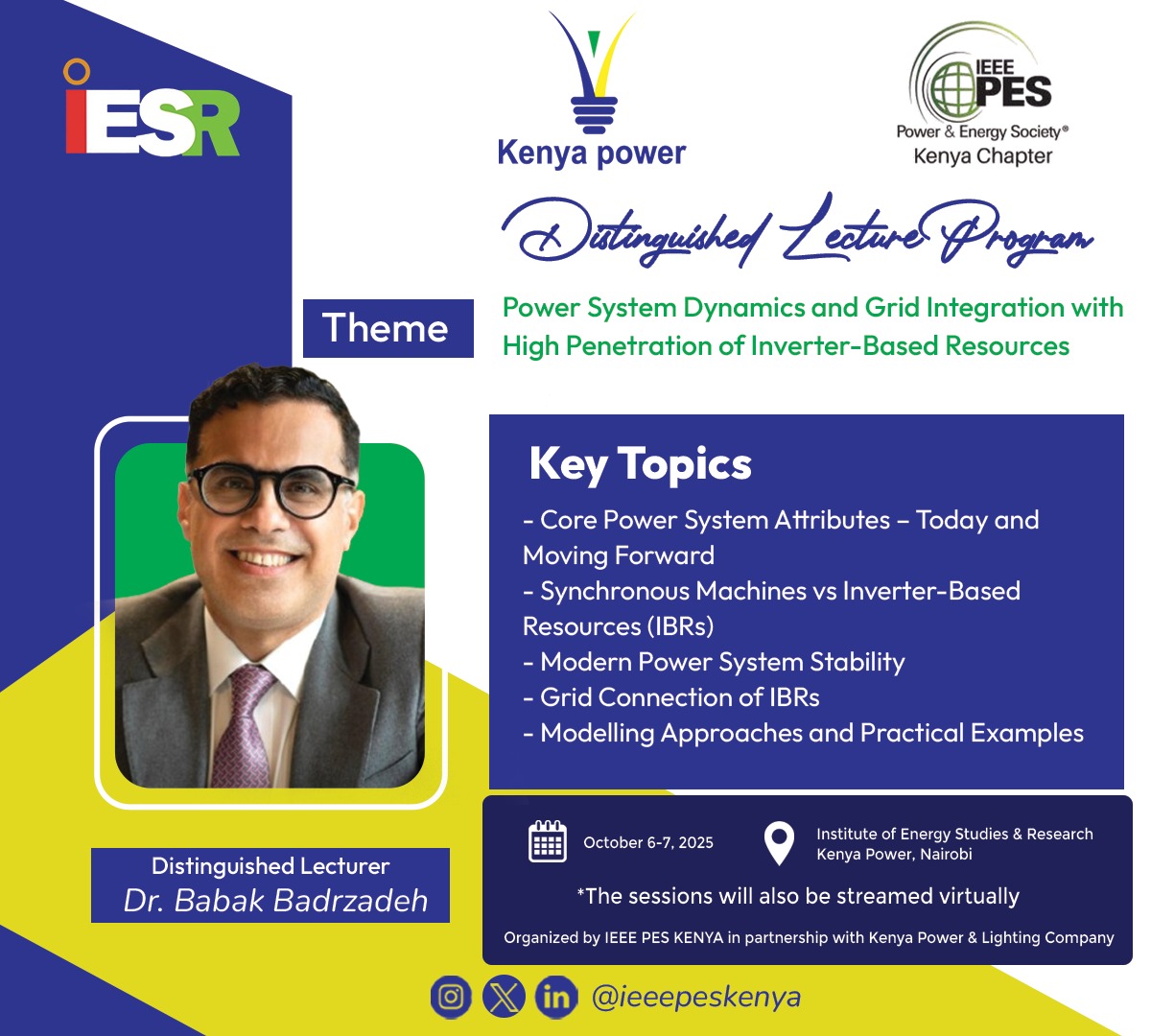Distinguished Lecture Program: Power System Dynamics and Grid Integration with High Penetration of Inverter-Based Resources
IEEE Power & Energy Society (PES) Kenya Chapter| In collaboration with Kenya Power & Lighting Company (KPLC)| Distinguished Lecture Program
The IEEE PES Kenya Chapter, in collaboration with the Kenya Power & Lighting Company (KPLC), is hosting a Distinguished Lecture Program featuring Dr. Babak Badrzadeh, IEEE PES Distinguished Lecturer. This lecture will explore power system dynamics and the integration of inverter-based resources, addressing modern stability challenges and practical approaches for renewable-ready grids. The event will bring together engineers, researchers, industry experts, and students to share knowledge and foster collaboration in advancing resilient power systems.
Date and Time
Location
Hosts
Registration
-
 Add Event to Calendar
Add Event to Calendar
Loading virtual attendance info...
- Institute of Energy Studies& Research (IESR)
- NAIROBI, Nairobi
- Kenya
- Click here for Map
- Contact Event Hosts
- Co-sponsored by Kenya Power & Lighting Company (KPLC)
- Starts 01 October 2025 09:00 PM UTC
- Ends 05 October 2025 09:00 PM UTC
- 0 in-person spaces left!
- No Admission Charge
Speakers
Dr. Babak Badrzadeh
Core Power System Attributes – Today and Moving Forward Synchronous Machines vs Inverter-Based Resources (IBRs) Modern
Biography:
-
Fellow of Engineers Australia
-
Adjunct Professor, Monash University
-
IEEE PES Distinguished Lecturer
Speaker Bio (for VTools):
Dr. Babak Badrzadeh is a leading power systems expert with over 21 years’ global experience across industry, academia and consultancy. He has worked on major grid connection projects, pioneered system strength and stability methodologies for high-renewable grids and advised operators, developers and policymakers worldwide. Recognized with the CIGRE Technical Council Award, Dr. Badrzadeh is an active contributor to IEEE PES and CIGRE and continues to shape the future of resilient, renewable-ready power systems.
Key Topics:
-
Core Power System Attributes – Today and Moving Forward
-
Synchronous Machines vs Inverter-Based Resources (IBRs)
-
Modern Power System Stability
-
Grid Connection of IBRs
-
Modelling Approaches and Practical Examples
Target Audience:
-
IEEE PES Members
-
Power System Engineers
-
Energy Researchers
-
Utility Professionals
-
Students in Electrical, Energy and Power Systems
Agenda
1. Core Power System Attributes – Today and Moving Forward
- Fault level
- System strength and inertia
- Damping
- Frequency and RoCoF
2. Key Differences: Synchronous Machines vs IBRs
- Physical vs control-based principles
- Fault current behaviour
- Introduction to IBR control fundamentals:
- Control layers (current/voltage/outer loops, DC-link)
- Fault ride-through & PLL behaviour during faults
- Grid-following vs grid-forming overview
3. Introduction to Modern Power System Stability
- Key system phenomena
- Stability phenomena and classifications
- Stability vs system strength
- Practical instability examples (resonances, oscillations, control interactions)
4. Grid Connection of IBRs
- End-to-end connection process
- Differences across countries
- Existing and emerging technical performance requirements
- Key assumptions about the broader system
5. Modelling Approaches
- Complementary use of phasor-domain and EMT modelling
- Practical examples
IEEE PES Kenya Chapter | Kenya Power & Lighting Company (KPLC)



